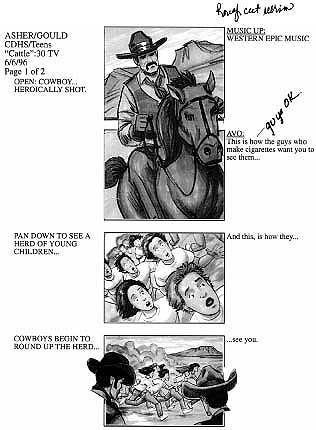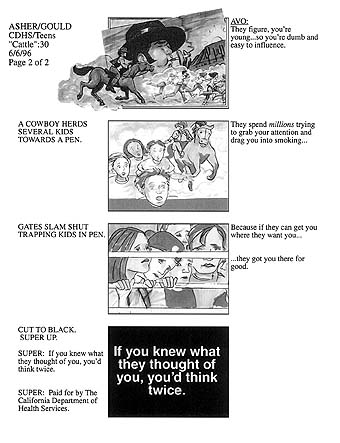Shutting Out the Public Health Community
During the first years of the California anti-tobacco media campaign, both DHS and the advertising agency had actively involved members of the public health community, including TEROC, in the development of the advertising campaign with the aim of coordinating the media campaign with the community-based tobacco control activities and receiving expert advice on the content of the campaign.[36] Recognizing that efforts to slow down and weaken the media campaign would spark controversy within the public health community, the administration shut this group out of the review process.
As the legislatively constituted oversight committee for the Proposition 99 program, TEROC had a particular interest in the development and implementation of the advertising campaign. TCS had routinely, if informally, involved TEROC in the development of the advertising campaign by asking its members to review storyboards for advertisements that were under development. The administration quit involving TEROC in the review of the storyboards. The administration argued that TEROC was a “security risk” and that sharing the advertisements with TEROC would increase the likelihood that the tobacco industry would gain access to them. To this, Cook responded, “The TEROC is not an outside party; it is to be part of the process; and it is being deprived of the tools necessary to function.”[37] One of the other TEROC members wryly observed that DHS apparently considered twelve-year-olds in a focus group less of a security risk than the TEROC members.[37]
At the December 10, 1996, meeting of TEROC, the committee discussed the delays in the media campaign and the new closed review process used for approving new media. Stratton announced that decision making about the media campaign had been removed from TCS. He also claimed that he had the final say over the content of the advertisements. No one believed him, but he was the first of a long line of officials
The veil of secrecy extended to the advertising firm as well. The new Asher/Gould contract issued on December 1, 1996, contained a new clause, nicknamed the “Silverman Clause,” barring the advertising agency from discussing the media campaign with anyone without prior written approval from DHS management.[40]
The administration had a good reason for wanting to keep TEROC and the other members of the public health community out of the process. They had secretly weakened the June advertisements, just as public health advocates had feared.
By the December 1996 TEROC meeting, all the storyboards submitted by Asher/Gould in June had been modified to remove the prohibited words “the tobacco industry” and “addiction.” “Cattle” now began with “This is how the guys who make cigarettes…,” and the final line was simply “If you knew what they thought of you, you'd think twice” (figure 25). The text of the advertisement “Thank You” had also been changed, from “The Tobacco Industry would like to thank…” to “Those of us who make cigarettes would like to thank you.” The final line, “Sincerely, the Tobacco Industry,” was still included in the December 5 presentation attended by TCS staff, Lynda Frost (deputy director of the Office of Public Affairs), Genest, and Stratton, but it was later deleted.[41]

Figure 25a. The toned-down version of “Cattle.” In accordance with Wilson adminstration policy, all references to the tobacco industry were deleted. In addition, the images were softened.

Figure 25b.
Another new advertisement, “Rain,” which featured cigarettes raining down on a playground, was based on the theme of hooking kids, but it never mentioned the tobacco industry by name. The opening line was “We have to sell cigarettes to your kids,” and the final line was “How low will they go to make a profit?” Viewers were left with the impression that the advertisement was about retailers.[42]
Another proposed new advertisement, “Voicebox” (later known as “Debi”), was to attack the industry for lying about nicotine addiction. It featured a woman smoking through a tracheostomy opening, stating that the tobacco industry had lied to her about the addictive nature of its products. At the December meeting, the industry attack approach was deleted, and the advertisement instead promoted the state's “800” quit line. In the revised December version neither of the prohibited terms “addiction” or the “tobacco industry” was used. The advertisement instead
The effort to tone down the attacks on the tobacco industry flew in the face of the research on message effectiveness that Asher/Gould had conducted for TCS. In response to requests from administration officials for more and more justification for the anti-industry strategy, Asher/Gould hired an outside evaluator to study the question. In a November 1996 summary of its focus group research on different advertising messages and in a December 1996 memo to Colleen Stevens, head of the media campaign at TCS, Christine Steele, the Asher/Gould senior vice president responsible for the campaign, reported the results.[43][44] Five advertising strategies were tested on youths between the ages of twelve and eighteen in focus groups in Sacramento and Los Angeles. The messages tested were: (1) manipulation of kids by the tobacco industry, (2) the dangers of secondhand smoke, (3) the short-term health effects of smoking, (4) the risk of romantic rejection, and (5) the elimination of risks to the environment caused by smoking, with results including cleaner beaches, fewer trees destroyed to produce cigarettes, and fewer animals harmed by eating butts. Of the five, manipulation by the industry was the strongest message in the groups. According to Steele, “The body language of kids clearly revealed that this [anti-industry] strategy provided kids with an emotional wake up call. They sat up straight, they grimaced, they shook their heads, they became riled up and vocal—they at least became concerned about this formerly `low interest' topic.”[44] The administration was unmoved.
The ACS, which had been passive through the battles with the administration, started to take more proactive positions in 1996. One reason may have been that the administration was ignoring TEROC chair Cook, a longtime and high-level volunteer in ACS. Another reason may have been to recover from an embarrassment that occurred when the ACS's San Francisco unit awarded tobacco industry ally Willie Brown its “Humanitarian of the Year” award.[45-48]
On February 4, 1997, the presidents of the ACS, AHA, and ANR wrote Smoley to express their frustration with the “administration's ostensible defense of an industry responsible for the deaths of more than 42,000 Californians each year—the tobacco industry.”[49] The three organizations protested the long delay in the production of new media
On April 15, 1997, the ACS, AHA, and ANR presidents wrote the governor requesting a meeting to discuss their concerns about the performance of his secretary of health and welfare.[50] The letter went unanswered for a month. On May 16, the governor's deputy chief of staff and cabinet secretary wrote saying, “I am aware of your previous communications with the Health and Welfare Agency and the Department of Health Services. Both Secretary Smoley and Director Belshé have forthrightly represented the Governor's position to you.”[51] Smoley, with Governor Wilson's explicit approval, was implementing Pringle's policy of refusing to attack the tobacco industry, even though the Legislature had rejected his language. The health groups accepted this rebuff quietly.